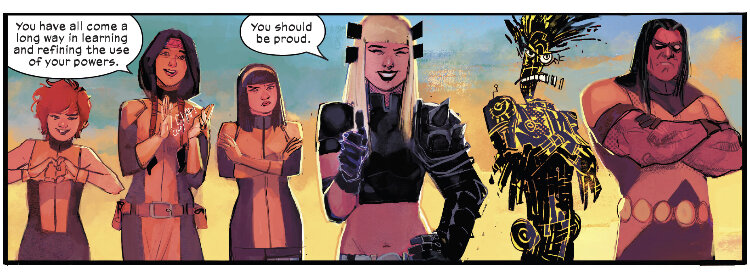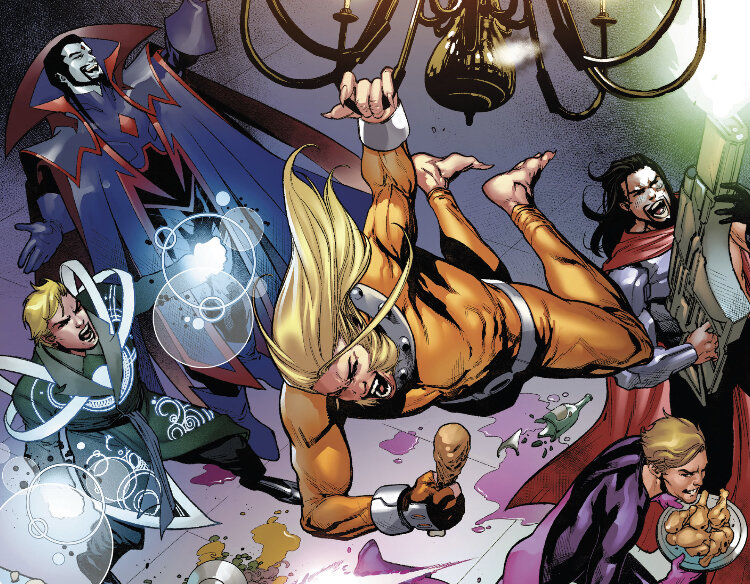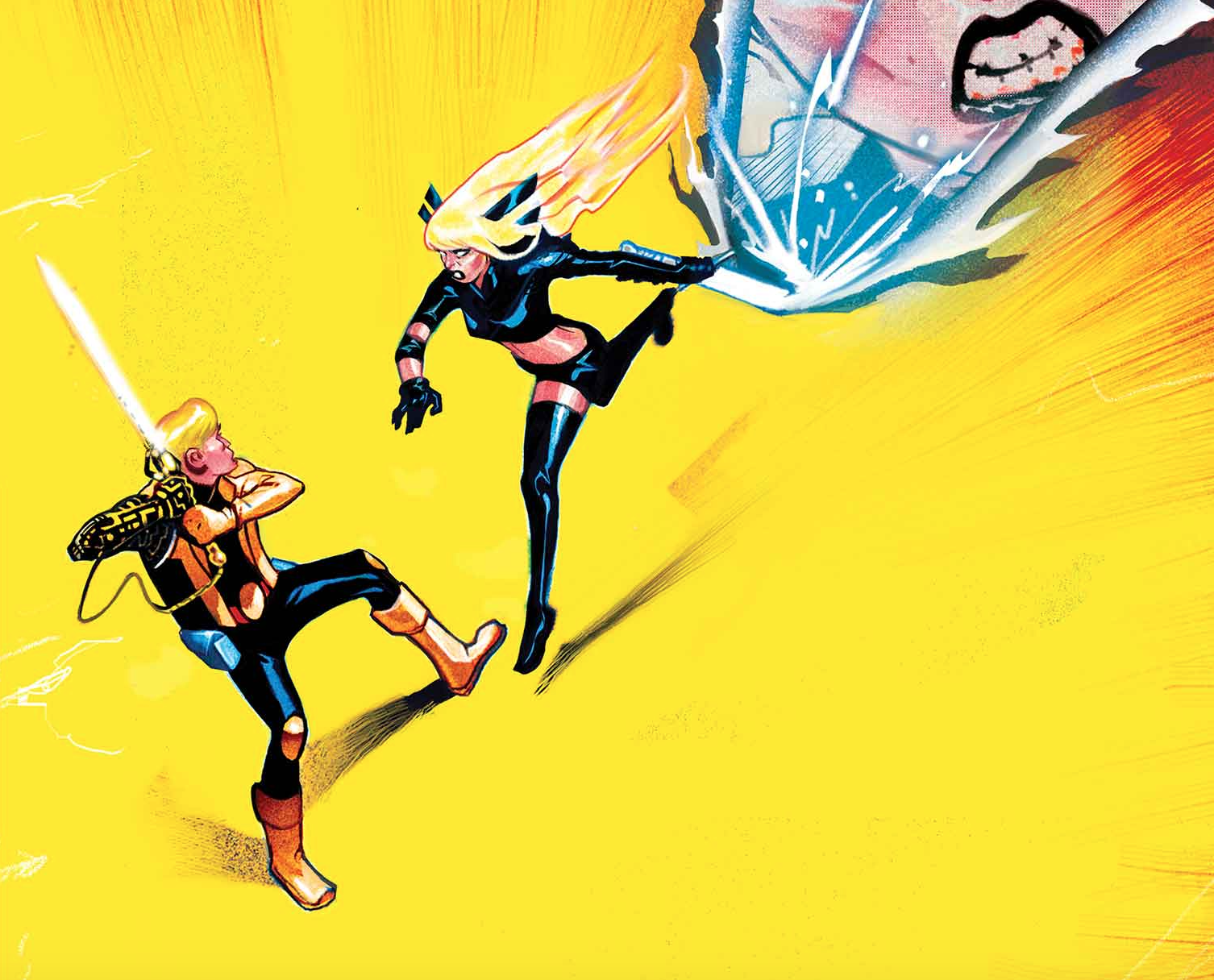Reign of X Mini-Reviews: New Mutants / Excalibur / Hellions
New Mutants 14-18
Written by Vita Ayala
Art by Rod Reis
Vita Ayala was a good choice to replace Ed Brisson on New Mutants – they have a very natural affinity for writing young characters, and immediately gave the series a focus and mission that was lacking in Brisson’s issues. Ayala has tightened up the core cast to a group of classic New Mutants characters – Mirage, Karma, Wolfsbane, Magik, Warlock, Warpath – and have put them in charge of an outreach program to help give structure and a sense of purpose to Krakoa’s youth, not all of whom know who or what they want to be in this new society. There’s enough action and adventure moments for it to work as a superhero series, but Ayala is writing a story about young mutants trying to find themselves and seeking out paths that don’t involve becoming a proper superhero and attempting to solve problems with violence.
Ayala’s strength as a writer lies in their empathy, and the plot of this run of issues is largely driven by characters’ pain and emotional needs, and how this makes some characters lash out and others become confused by conflicting feelings. The main story is about the Amahl Farouk – the sinister telepath who is the host of the demonic psychic creature the Shadow King – also deciding to become a mentor to young mutants, and manipulating some particularly vulnerable kids who’ve been traumatized by their mutations to seek ways to change their circumstances.
Ayala carries over the Brisson creation Cosmia for this plot – she’s a teenager who hideously warped her body and just wants to be reset in her original form so she can feel like a normal person again. This is a very understandable angst, and it’s hard not to side against the book’s own protagonists when they – mutants, but normal looking humans – try to tell her that her mutation is who she is and thus beautiful in its own way. Ayala is very good at puncturing the sort of well-meaning but patronizing things we say to people in pain, and doing it in a way that doesn’t totally undermine a character like Mirage’s wisdom and generosity.
Rod Reis’ loosely gestural and very colorful art remains a major highlight of this series, and his skill for conveying nuanced emotion in facial expressions and body language adds a lot of depth to what Ayala is trying to achieve in their character writing. Reis is also terrific with atmosphere and nails the pages where Ayala asks for psychedelic horror or storybook grandeur. Ayala is aiming high, but Reis is elevating the material on every page.
Excalibur 16-20
Written by Tini Howard
Art by Marcus To
Color art by Erick Arciniega
Given that X of Swords spent a lot of time establishing the terrain of Otherworld and gesturing towards the many story opportunities offered among its realms it has been very disappointing that in the immediate wake of that story Excalibur – the X-Men series focused on Otherworld adventures – brushed all that aside for five consecutive issues telling the convoluted story of Betsy Braddock coming back after seemingly dying in the crossover.
There is some narrative value in this plot as it provided an opportunity for Tini Howard to get around to exploring the complicated relationship of Betsy and Kwannon, but I don’t think we get anything very deep here. Ultimately Kwannon forgives Betsy for inhabiting her body for many years and moves along in the role of Psylocke, but it feels more she’s making a legal statement after a court settlement than anything that feels emotionally natural.
Howard’s writing is still frustrating. She has good ideas and a strong notion of who Betsy Braddock is, and I’m intrigued by her exploring the character by putting her through a series of failures. But the best elements of Excalibur are mostly conceptual, and I think she stumbles through plotting on an issue-to-issue level and in making use of her full ensemble cast. At this stage it’s pretty clear that Excalibur is ultimately a Betsy Braddock solo series with a large supporting cast, and not a proper team book as it’s sold. Rogue, one of the best and most beloved X-Men characters, has spent 20 issues of this series essentially playing the role of “Betsy’s friend” without any real story of her own. Gambit fares even worse, mainly playing the role of “Rogue’s husband.” Jubilee and Rictor get a little more to do, but their stories are presented as minor relative to things directly pertaining to Betsy.
Unlike the second arc of Marauders in which Gerry Duggan took Kate Pryde off the board and used it as a way of exploring the other characters in the series, Howard took Betsy Braddock out of Excalibur so the other characters could mostly just talk about missing her and trying to bring her back. I like Betsy Braddock a lot, she’s one of my favorite X-Men characters, and don’t mind this sort of focus on her but it’s time for this series to be more honest about what it is. Rogue getting reassigned to Duggan’s new X-Men series is a good sign, both for the good of that character, and for Excalibur moving away from wasting major characters in the orbit of Braddock.
Howard has clearly made some effort to tell a complete plot in any given issue, at least in terms of setting an obstacle and overcoming it, but for the most part these seem weirdly inconsequential. Maybe part of the problem is how abstract the conflicts tend to be, particularly in a set of issues like these where everything’s so psychic and mystical and not rooted in physicality or social dynamics. Even when this storyline gets a proper antagonist in the form of Malice, the story ends up defeating the concept of the character – a disembodied psychic creature that hijacks bodies – by fleshing out her backstory and giving her a body in the end. Howard aims for pathos in telling Malice’s story, but it mostly just comes across as corny and as a clumsy parallel to Betsy’s own history.
Marcus To’s art continues to be pleasantly average in scenes that are mostly talking and hanging out, and egregiously bland and flat whenever he’s asked to draw anything particularly fantastical, which is quite often in a series largely focused on fantasy genre scenes and psychic abstractions. Given that Howard’s writing has come off much better when paired with heavyweights Pepe Larraz, R.B. Silva, Phil Noto, and Mahmud Asrar on X of Swords, it’s very likely that these issues would have come across much better if To was not the artist.
Hellions 7-12
Written by Zeb Wells
Art by Stephen Segovia
Color art by David Curiel
Hellions remains a highlight of the line as Zeb Wells explores some of the most warped X-Men characters with equal measures of dark wit and empathetic nuance. Wells is very good at making sure his eight characters get a roughly even amount of spotlight in any given story but in this run of issues we get a little deeper into the three weirdest cast members – Nanny, Orphan Maker, and Wild Child. The sorta contrived narrative reason for this is that after being resurrected from having died in Arakko the three have come back as “sharpened” versions of themselves, i.e., like even more themselves than they were before. In effect this means that Orphan Maker is even more petulant and childish, Nanny is more vindictive and monomaniacal, and Wild Child struggles with his profound primal urge to be an alpha while consistently finding himself in situations where he most definitely is not. Wells gets a particularly good scene out of this subplot in the Hellfire Gala issue in which Wild Child runs into his ex-girlfriend Aurora and finds that not only is she embarrassed by her past association with him, but she’s also with Daken, a bigger and more obviously alpha version of Wild Child. Wells manages to take the character’s plight - rooted in toxic masculinity and powerful incel vibes - and make it weirdly poignant without making him come across any less creepy and psychotic.
Wells’ plotting is strong, particularly in the run of issues in which the cast is held captive by Arcade and Mastermind, but the pleasure of this series is in the genuinely funny dialogue and the way Wells gradually deepens the relationships between these demented and/or broken weirdos. Greycrow in particular has benefited from this as he demonstrated a fraternal warmth towards Wild Child, a respectful comradery with Havok, and a slow-simmering romantic chemistry with Psylocke. The broader question of the series is “can these people change and be rehabilitated?” and the ongoing story of Greycrow suggest that he can be if he continues to forge real connections rather than maintain an icy loner lifestyle that allowed him to see other people’s lives as useless and disposable.
Havok’s role in the series is to essentially be the “straight man” among the lunatics, but Wells does a good job of making it clear that he’s just as broken as the rest. In the Gala issue we are reminded that any status Havok has is due to him being Cyclops’ brother, and that authority figures like Xavier and Magneto seem to view him as a pathetic figure they must be superficially kind to as a favor to Cyclops. This feeds into the character’s delusion that he doesn’t belong amongst the Hellions, but also fuels the years of sudden volcanic anger and bad choices sparked by rampant insecurity that’s put him in this position.







